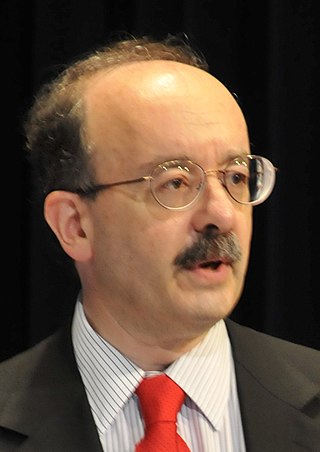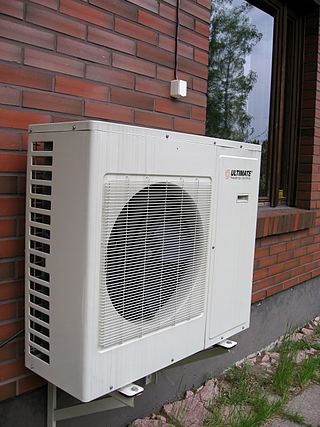
Amory Bloch Lovins is an American writer, physicist, and former chairman/chief scientist of the Rocky Mountain Institute. He has written on energy policy and related areas for four decades, and served on the US National Petroleum Council, an oil industry lobbying group, from 2011 to 2018.

Distributed generation, also distributed energy, on-site generation (OSG), or district/decentralized energy, is electrical generation and storage performed by a variety of small, grid-connected or distribution system-connected devices referred to as distributed energy resources (DER).

A power outage is the loss of the electrical power network supply to an end user.

Energy development is the field of activities focused on obtaining sources of energy from natural resources. These activities include the production of renewable, nuclear, and fossil fuel derived sources of energy, and for the recovery and reuse of energy that would otherwise be wasted. Energy conservation and efficiency measures reduce the demand for energy development, and can have benefits to society with improvements to environmental issues.

The Rocky Mountain Institute, commonly abbreviated to RMI, is an organization in the United States co-founded by Amory Lovins dedicated to research, publication, consulting, and lecturing in the field of sustainability, with a focus on profitable innovations for energy and resource efficiency. RMI was established in 1982 and has grown into a broad-based institution with over 600 staff and an annual budget of $120+ million. RMI's work is independent and non-adversarial, with an emphasis on market-based solutions.

In 1976, energy policy analyst Amory Lovins coined the term soft energy path to describe an alternative future where energy efficiency and appropriate renewable energy sources steadily replace a centralized energy system based on fossil and nuclear fuels.
A microgrid is a local electrical grid with defined electrical boundaries, acting as a single and controllable entity. It is able to operate in grid-connected and in island mode. A 'stand-alone microgrid' or 'isolated microgrid' only operates off-the-grid and cannot be connected to a wider electric power system. Very small microgrids are called nanogrids.

Negawatt power is investment to reduce electricity consumption rather than investing to increase supply capacity. In this way, investing in negawatts can be considered as an alternative to a new power station and the costs and environmental concerns can be compared.

L. Hunter Lovins is an American environmentalist, author, sustainable development proponent, co-founder of Rocky Mountain Institute, and president of the nonprofit organization Natural Capitalism Solutions.

Soft energy technologies may be seen as appropriate renewable technologies. Soft energy technologies are not simply renewable energy technologies, as there are many renewable energy technologies which are not regarded as "soft". The character string including "Soft Energy" is a registered trademark of Soft Energy Controls Inc. in Japan.

Winning the Oil Endgame: Innovation for Profits, Jobs and Security is a 2005 book by Amory B. Lovins, E. Kyle Datta, Odd-Even Bustnes, Jonathan G. Koomey, and Nathan J. Glasgow, published by the Rocky Mountain Institute. It presents an independent, transdisciplinary analysis of four ways to reduce petroleum dependence in the United States:

The smart grid is an enhancement of the 20th century electrical grid, using two-way communications and distributed so-called intelligent devices. Two-way flows of electricity and information could improve the delivery network. Research is mainly focused on three systems of a smart grid – the infrastructure system, the management system, and the protection system. Electronic power conditioning and control of the production and distribution of electricity are important aspects of the smart grid.
The environmental benefits of renewable energy technologies are widely recognised, but the contribution that they can make to energy security is less well known. Renewable technologies can enhance energy security in electricity generation, heat supply, and transportation. Since renewable energy is more evenly distributed than fossil fuels at the global level, the use of renewable energy technologies can also lead to decentralized and self-sufficient energy systems and reduce energy dependencies among countries.

100% renewable energy is the goal of the use renewable resources for all energy. 100% renewable energy for electricity, heating, cooling and transport is motivated by climate change, pollution and other environmental issues, as well as economic and energy security concerns. Shifting the total global primary energy supply to renewable sources requires a transition of the energy system, since most of today's energy is derived from non-renewable fossil fuels.
David A. Schlissel has been a Senior Consultant with Synapse Energy Economics since 2000. For 30 years he has worked on complex engineering and economic issues mainly in the field of energy management. This work has ranged from conducting technical investigations, through to presenting expert testimony. Schlissel has undergraduate and advanced engineering degrees from the Massachusetts Institute of Technology and Stanford University, and a law degree from Stanford Law School.

An electrical grid is an interconnected network for electricity delivery from producers to consumers. Electrical grids consist of power stations, electrical substations to step voltage up or down, electric power transmission to carry power over long distances, and finally electric power distribution to customers. In that last step, voltage is stepped down again to the required service voltage. Power stations are typically built close to energy sources and far from densely populated areas. Electrical grids vary in size and can cover whole countries or continents. From small to large there are microgrids, wide area synchronous grids, and super grids.

Policy makers often debate the constraints and opportunities of renewable energy.

An energy transition is a major structural change to energy supply and consumption in an energy system. Currently, a transition to sustainable energy is underway to limit climate change. As much sustainable energy is renewable it is also known as the renewable energy transition. The current transition aims to reduce greenhouse gas emissions from energy quickly and sustainably, mostly by phasing-down fossil fuels and changing as many processes as possible to operate on low carbon electricity. A previous energy transition perhaps took place during the Industrial Revolution from 1760 onwards, from wood and other biomass to coal, followed by oil and later natural gas.
The vulnerability of nuclear plants to deliberate attack is of concern in the area of nuclear safety and security. Nuclear power plants, civilian research reactors, certain naval fuel facilities, uranium enrichment plants, fuel fabrication plants, and even potentially uranium mines are vulnerable to attacks which could lead to widespread radioactive contamination. The attack threat is of several general types: commando-like ground-based attacks on equipment which if disabled could lead to a reactor core meltdown or widespread dispersal of radioactivity; external attacks such as an aircraft crash into a reactor complex, or cyber attacks.













